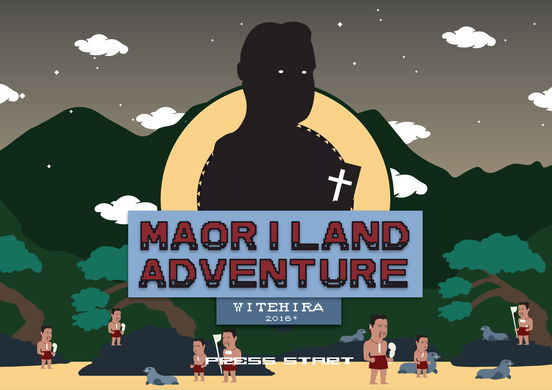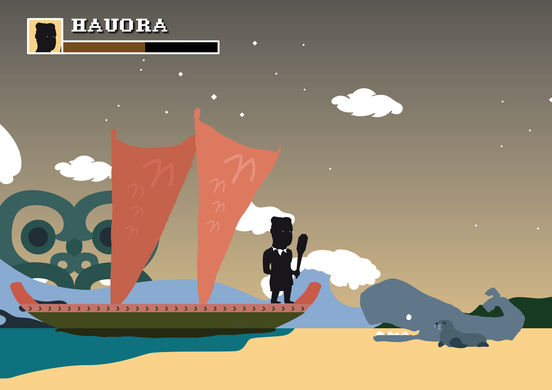-
Author
Megan Tamati-Quennell -
Date
1 Oct 2016
Essay
Half-Blood
Johnson Witehira, 2016
Wheako whakarara/side by side
Cliff Whiting in his foreword featured in the late Roger Neich’s seminal book Painted Histories, Early Maori figurative painting, talks about the change in practice from carved to painted meeting houses, particularly those built for Maori leader, protagonist for political change and founder of the Ringatu religion/Maori faith, Te Kooti Arikirangi Te Turuki. Whiting’s introduction, which sets the tone for the publication, outlines the transformation of the Maori meeting house with the use of this new medium and the development of new art forms. He accentuates the negotiation of tikanga (right practice according to Maori lore) assumed by those individuals using paint, a substance that held spiritual power within Te Ao Maori (the Maori world) as the first paint kokowai (red ochre) was associated with Maori origins, the blood spilt through the separation of Ranginui and Papatuanuku. He stresses the boldness and confidence of their use of figurative paintings, pictorial representations of our history and tupuna (ancestors), and relays the challenges and freedoms that the change allowed for Maori artists. The challenges included figures painted without heads in a Manutuke Church as the tohunga were not willing to commit the most essential part of an ancestor to the new medium of paint, and the independence and freedoms paint provided, with Maori artists able to experiment, as painting did not create a residue like the wood chips in carving that could make a ‘negative form’ of an ancestor and required the knowledge of the right karakia (prayer) to diminish that occurrence.
Neich’s book, a key text for anyone who studies Maori art or art history, particularly that of whare whakairo, the Maori meeting house, parallels the daring of Johnson Witehira’s synthesis and evolution of the digital medium as a Maori art form, a medium he specialises in as an artist and designer and uses without compromise. His work draws philosophically from the precedent set by the artists of the painted meeting houses that flourished in the late part of the 19th century and recorded by Neich as far north as Dargarville in the North Island, that developed liberally on the East Coast and inland in the rohe (area) of Tuhoe where the Ringatu religion was taken up and practiced (and still is) and as far south as Levin. Connections can be made with Witehira’s championing of a new medium and art form, but also to what the medium signifies. Like the painted meeting houses, Witehira’s work symbolises the formation of new Maori identities.
‘Ringatu teaching and the experience of the Maori Land Court changed Maori historical consciousness and led to the construction of new tribal identities based on specific histories as much as genealogy. As the symbol of group identity, the decorative scheme of the meeting house was transformed to give visual expression to these new historical narratives.’ 1
Witehira’s work speaks of his background, his urban Maori reality and the visual lexicon of 2D graphic art and design that informed him and his practice. Comics, video games and animation, the ubiquitous art forms of popular culture, were omnipresent in the 1980s and 1990s and were central influences for Witehira and his generational contemporaries. The platform of the video game is the medium Witehira uses for his artwork in Half-blood. Made up of two playable digital narratives projected side by side, the works explore our settlement history, the arrival of the Maori and the arrival of the Pakeha. The provocative exhibition title Half-blood is 80s arcade video game slang, the act of handing over the controls of a game to a better player when half the game has been played or when half the life of the game character is all that is left. It also refers to Witehira’s Maori blood quantum, to his racial makeup. It reveals that he is a half-caste; that he is of dual Maori and Pakeha descent. Witehira often refers to the ‘third space’ of being a half-caste. The concept of third space works with ideas of hybridity and draws on the thinking of postcolonial theorist Homi K Bhabha. Bhabha proposed that all forms of culture are continually in a process of hybridisation. That hybridity forms a third space and that the third space can be interpreted as ‘a space of translation … that is new, neither one or the other’ 2. A space Bhabha said, that displaces the histories it was made it up of and enables other positions to emerge.

Johnson Witehira, Half-Blood, 2016. Image: courtesy of the artist

Johnson Witehira, Half-Blood, 2016. Image: courtesy of the artist
Using brutal humour Half-blood explores historical truths and explodes contemporary myths associated with subsistence and settlement. The Maori centered artwork highlights the impact of Maori arrival to Aotearoa, our devastation of flora and fauna and the landscape to enable our survival, rather than the perpetuation of the fallacy of early Maori being the kaitiaki or guardians of the environment. The Pakeha centred artwork focuses on the colonial strategy of assimilation for Pakeha survival and success. The assimilation strategy employed includes missionaries throwing bibles at the natives and the missionaries’ acquisition of te reo and Maori custom to accelerate the absorption of Maori into the Pakeha world.
Witty and clever, the two ‘Maoriland Adventure’ artworks not only draw on historical accuracies, they also contain Maori art historical references from the triangle forms of taaniko (Maori finger weaving) designs, to the narrative characters fashioned from the painted figures in late 19th century painted meeting houses. Further and more contemporary references include Louis J. Steele and Charles Goldie’s contrived and fabricated 1898 painting — The Arrival of the Maoris in New Zealand and Maori painter Shane Cotton’s ‘falling birds’. Witehira’s reinterpretation and use of Maori art historical references in his artwork supports Dr Rangihiroa Panoho’s proposition in his recent book Maori Art, History, Architecture, Landscape and Theory, that Maori art is a palimpsest. In all aspects of this work Witehira highlights that his work which uses the contemporary mediums of 2D graphic design and digital imagery, belongs to the ‘evolution and sequence’ 3
of Maori art and is an art, as Panoho outlines, that is altered in response to new conditions, but still bears visible traces of its earlier forms.
—
Megan Tamati-Quennell is an art curator who specialises in Modern & Contemporary Maori and Indigenous art. She has a leading art curatorial practice that spans over two decades that began with an internship at the National Art Gallery in 1990. Megan has been at the forefront of many developments in her specialist field, which she describes as ‘art made on the margin between indigenous and the mainstream’.
Johnson Witehira is an artist and designer of Ngā Puhi (Ngai-tū-te-auru), Tamahaki (Ngāti Hinekura), and Pākehā descent. He graduated from the Whanganui School of Design in 2007, going on to complete his Masters in 2007. His interest in Maori visual art led him to Massey University where he completed a doctorate (2013) that explored both the aesthetics and tikanga in customary Maori art. As an artist Witehira’s work often explores identity and the space between cultures. He has worked on a diverse range of creative projects, from solo and group exhibitions, to public art including murals, light-box works and projected light installations. In 2012 Witehira’s work was exhibited in Times Square, New York in the first ever syncronised display of digital content. In his Land of Tara (2014, Wellington) series Witehira worked created a series of graphic representations of the capital city’s ancestors including Kupe, Whatonga, and his sons Tautoki and Tara. More recently Witehira was invited to show his work at the prestigious Talente Munich in Germany (2015).
- 1.Roger Neich, Painted Histories, Early Maori figurative painting, inside cover, Auckland University Press, 1994
- 2.Graham Fletcher, ‘Myth, Magic, Mimicry, and the Cross-Cultural Imaginary’, unpublished doctoral exegesis, Elam School of Fine Arts, University of Auckland, 2010, p.4
- 3.Cliff Whiting, foreword, Painted Histories, Early Maori figurative painting, p. 5, Auckland University Press, 1994

Johnson Witehira, Half-Blood, 2016. Image: courtesy of the artist